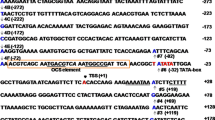Abstract
Gel shift mobility analysis, using the proximal 0.3 kb fragment of the tobacco pathogenesis-related protein la gene (PR-1a) and nuclear extracts from healthy Samsun NN tobacco leaves, which do not produce PR-1 proteins, showed a broad shifted signal with low mobility. This signal was not detected with nuclear proteins from the interspecific hybrid of Nicotiana glutinosa x Nicotiana debneyi, which constitutively produces the PR-1a protein. Similar shifted signals were detected with both proximal and distal regions of the 0.3 kb fragment using nuclear proteins from healthy Samsun NN tobacco, but not with proteins from the interspecific hybrid. Further experiments, performed using 5′ or 3′ truncated fragments of the 0.3 kb fragment, identified two independent binding sites: a distal site between −179 and −168 by from the transcription start site, and a proximal site between −61 and −37 bp. Footprint analysis revealed two protected sequences, a distal region between −184 and −172 bp, and a proximal region between −68 and −51 bp. These results indicate the presence of regulatory factor(s) for expression of the acidic PR-1a gene. The possibility of negative regulation of the gene is discussed.
Similar content being viewed by others
References
Ahl G, Gianinazzi S (1982) b-protein as a constitutive component in highly (TMV) resistant interspecific hybrids of Nicotiana glutinosa × Nicotiana debneyi Plant Sci Lett 26:173–181
Beilmann A, Pfitzner AJP, Goodman HM, Pfitzner UM (1991) Functional analysis of the pathogenesis-related la protein gene minimal promoter region: comparison of reporter gene expression in transient and in stable transfections. Eur J Biochem 196:415–421
Berg PE, Williams DM, Qian R-L, Cohen RB, Cao S-X, Mittelman M, Schechter AN (1989) A common protein binds to two silencers 5′ to the human β-globin gene. Nucleic Acids Res 18:8833–8852
Bradford MM (1976) A rapid and sensitive method for the quantitation of microgram quantities of protein utilizing the principle of protein-dye binding. Anal Biochem 72:248–254
Chen Z, Klessig DF (1991) Identification of soluble salicylic acidbinding protein that may function in signal transduction in the plant disease-resistance response. Proc Natl Acad Sci USA 88:8179–8183
Davidson I, Xiao JH, Rosales R, Staub A, Chambon P (1988) The HeLa cell protein TEF-1 binds specifically and cooperatively to two SV40 enhancer motifs of unrelated sequence. Cell 54:931–942
Fukuda Y, Ohme M, Shinshi H (1991) Gene structure and expression of a tobacco endochitinase gene in suspension cultured tobacco cells. Plant Mol Biol 16:1–10
Green PJ, Kay SA, Chua N-H (1987) Sequence-specific interactions of pea nuclear factor with light-responsive elements upstream of the rbc-3A gene. EMBO J 6:2253–2259
Harrison MJ, Choudhary AD, Dubery I, Lamb CJ, Dixon RA (1991) Stress responses in alfalfa (Medicago sativa L.). 8. Cis-elements and trans-acting factors for quantitative electroporated alfalfa protoplasts. Plant Mol Biol 16:877–890
Holdsworth MJ, Laties GG (1989) Site-specific binding of a nuclear factor to the carrot extensin gene is influenced by both ethylene and wounding. Planta 179:17–23
Kuwabara MD, Sigman DS (1987) Footprinting DNA-protein complexes in situ following gel retardation assays using 1,10-phenanthroline-copper ion: Escherichia coli RNA polymerase-lac promoter complexes Biochemistry 26:7234–7238
Lawton MA, Dean SM, Dron M, Kooter JM, Kragh KM, Harrison MJ, Yu L, Tanguary L, Dixon RA, Lamb CJ (1991) Silencer region of a chalcone synthase promoter contains multiple binding sites for a factor SBF-1, closely related to GT-1. Plant Mol Biol 16:235–249
Malamy J, Carr JP, Klessig DF, Raskin I (1990) Salicylic acid: a likely endogenous signal in the resistance response of tobacco to viral infection. Science 250:1002–1004
Maniatis T, Fritcsh EF, Sambrook J (1982) Molecular cloning. A Laboratory manual. Cold Spring Harbor Laboratory Press, Cold Spring Harbor, New York
Maxam AM, Gilbert W (1980) Sequencing end-labeled DNA with base-specific chemical cleavages. Methods Enzymol 65:499
Ohashi Y, Ohshima M, Itoh H, Matsuoka M, Watanabe S, Murakami T, Hosokawa D (1992) Constitutive expression of stress-inducible genes, including pathogenesis-related 1 protein gene in a transgenic interspecific hybrid of Nicotiana glutinosa × Nicotiana debneyi. Plant Cell Physiol 33:177–187
Ohshima M, Matsuoka M, Yamamoto N, Tanada Y, Kano-Murakami Y, Ozeki Y, Kato A, Harada N, Ohashi Y (1987) Nucleotide sequence of the PR-1 gene of Nicotiana tabacum. FEBS Lett 225:
Ohshima M, Harada N, Matsuoka M, Ohashi Y (1990a) The nucleotide sequence of pathogenesis-related (PR) 1b protein gene of tobacco. Nucleic Acids Res 18:181
Ohshima M, Harada N, Matsuoka M, Ohashi Y (1990b) The nucleotide sequence of pathogenesis-related (PR) 1c protein gene of tobacco. Nucleic Acids Res 18:182
Ohshima M, Itoh H, Matsuoka M, Murakami T, Ohashi Y (1990c) Analysis of stress-induced or salicylic acid-induced expression of the pathogenesis-related 1a protein gene in transgenic tobacco. Plant Cell 2:95–106
Pfeifer K, Prezant T, Guarente L (1987) Yeast HAPI activator binds to two upstream activation sites of different sequence. Cell 49:19–27
Van de Rhee MD, Van Kan JAL, Gonzalez-Jaen MT, Bol JF (1990) Analysis of regulatory elements involved in the induction of two tobacco genes by salicylate treatment and virus infection. Plant Cell 2:357–366
Van Loon LC (1985) Pathogenesis-related proteins. Plant Mol Biol 4:111–116
Ward ER, Uknes SJ, Williams SC, Dincher SS, Wiederhold DL, Alexander DC, Ahl-Goy P, Metraux J-P, Ryals JA (1991) Coordinate gene activity in response to agents that induce systemic acquired resistance. Plant Cell 3:1085–1094
White RF (1979) Acetylsalicylic acid (Aspirin) induces resistance to tobacco mosaic virus in tobacco. Virology 99:410–412
Yalpani N, Silverman P, Wilson TMA, Kleier DA, Raskin I (1991) Salicylic acid is a systemic signal and an inducer of pathogenesis-related proteins in virus-infected tobacco. Plant Cell 3:809–818
Author information
Authors and Affiliations
Additional information
Communicated by J. Schell
Rights and permissions
About this article
Cite this article
Hagiwara, H., Matsuoka, M., Ohshima, M. et al. Sequence-specific binding of protein factors to two independent promoter regions of the acidic tobacco pathogenesis-related-1 protein gene (PR-1). Molec. Gen. Genet. 240, 197–205 (1993). https://doi.org/10.1007/BF00277057
Received:
Accepted:
Issue Date:
DOI: https://doi.org/10.1007/BF00277057




